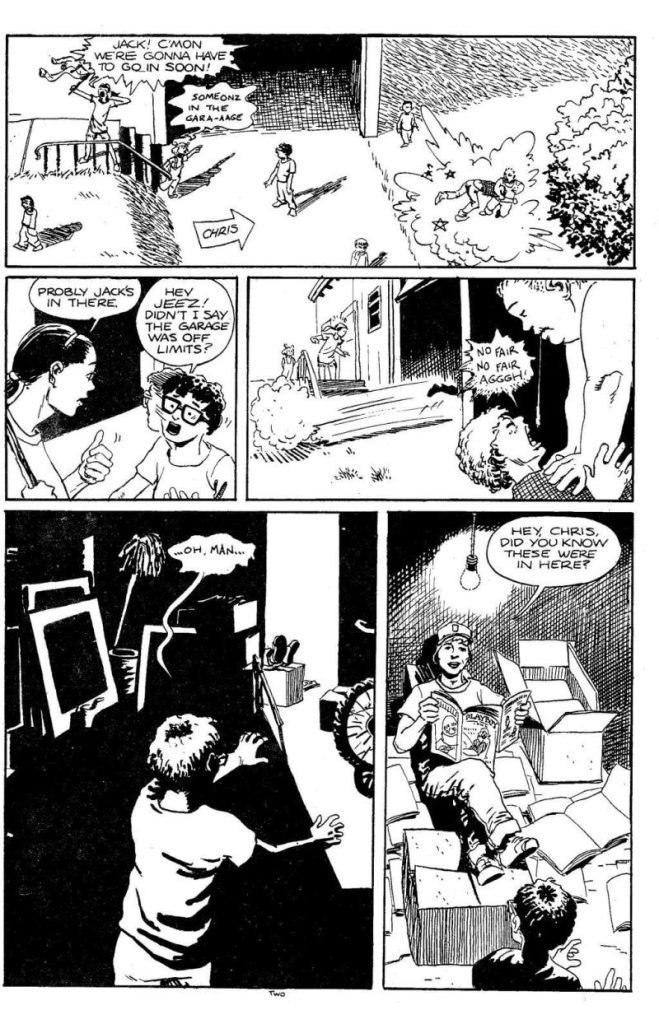Anthology
Caliber Comics 1993
A CHANCE REFERENCE sent me to the 1990s to investigate NEGATIVE BURN, a phenomenal anthology of legendary and legerdemain artists in black and white, still smoldering in the back stacks at your local comic shop. It was new to me. Maybe to you, too.

Early issues of the 50-issue run of Negative Burn are surprisingly tasty. Vignettes last a page, or many pages, swing in for a cameo, stretch in a sketchbook, slip through a variety of styles and scenery within a boundary of high quality that keeps moving forward in fascinating little stories, humor, and wackiness in unexpected places. Part of the burn involves reimagining where to look for drama. The skits often end abruptly, with an unusual outcome or something like no outcome, where the point dangles and one is left pondering on the tip.
Succeeding years did not run out of talent. Skip forward to 1996, Issue 37, after the title expanded to 64 pages, and the same diversity and probing quality of the art and drama remains.

Issue 37 starts with a tantalizing poker episode in the career of “Dusty Star” by writer Joe Pruett with “crappy drawings” not at all crappy by illustrator Andrew Robinson. Next comes the familiar park‑bench character “Mr. Mamoulian” by Brian Bolland in a one-page skit so dry, and wry as ever. The distracted guy wrapped in overcoat and scarf with wild hair features in every issue I’ve seen; I typically chuckle abruptly, sit a minute, and chuckle again fleetingly over the clever bits stashed in the monologuish conversation always initiated and ended by Mr. M’s charged visitor.
Then on to “The Thirst” written by Darko Macan, illustrated by Edvin Biukovic in dark shadows. The four‑page story fits the signature format, turning what looks like a ho-hum vampire hunt for blood into something else, in this case, sympathy for another being who thirsts like you. Here, drink. Anyone is liable to be drawn to the virtue of hospitality, and anyone bestowed it.
The wondrous page that follows in lightly lined panels, “Morgen (Tomorrow)” by artist P. Craig Russell, offers a peaceful assurance of unity between I and You, as “speechless, we shall gaze in each other’s eyes”—an idea previously wrecked by artist Brian Bolland—but here instead, “the speechless silence of happiness will fall on us”; only eyes away, darling. A good riposte.

The next one I found best, “Who is the Wretch” by artist Phillip Hester (inks Paul Fricke), featuring seven interviews with folks with theories about the secret identity of the super-guy who recently appeared in public, be he villain, hero, demon, or maybe a semi-functional figment of our imagination. Reality is never one sure thing. It’s a multiverse out there, peppered with black holes, as shown in the “dropout” response from Dewey, with Golly smokin’ in the background: “The Wretch, huh? … uhh … … … “Hey man, could you buy us a six-pack from the Stop-N-Go?”
Among the remaining skits and sketches, two disappointments stand out. A piece by writer Warren Ellis turned depraved and despicable to a degree I had to stop. He has done this to me several times now, casting a shadow on other works I admire greatly. Same goes for Alan Moore in this issue, whose textual warbling, here as in earlier issues, is purplish stonish indulgent rubbish, accompanied by one or another iconoclast artist posing alongside. The gibe reminds me of a remark by Arthur Conan Doyle in his memoir advising authors ought to take care that their own work one day not become their own worst enemy.
Dips and turns are expected in this kind of anthology. The best thing in the endeavor for the artists involved is the opportunity for a handful of years to burn, to fashion a combustible pile in the negative zone built on shadows and ink, and light it up. Also best, a generation or two later, more mysteriously, we can still breathe the fumes, and enjoy the flavor.

